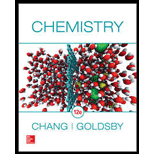
Define these terms: system, surroundings, open system, closed system, isolated system, thermal energy, chemical energy, potential energy, kinetic energy, law of conservation of energy.
Interpretation:
The given terms have to be defined.
Explanation of Solution
System: System can be defined as portion of universe. The physical and chemical changes of substance generally constitute a system.
There are types of system in thermodynamics namely,
- 1. Open system
- 2. Closed system
- 3. Isolated system
Surroundings: Surrounding can be defined as rest of universe other than the system.
Consider, the example of acid-base neutralization reaction,
The reactants
Open system: The free exchange of matter and energy with its surroundings is called as open system. The exchange of matter in open system takes place either by addition of matter or removal of matter. The exchange of energy is much more complicated than exchange of heat. The exchange of energy takes place through heat and through work.
Closed system: The exchange of energy with its surroundings and not matter is called as closed system. The transfer of energy is similar to that of open system
Isolated system: Either exchange of energy or matter takes place with the surroundings is called isolated system.
Thermal energy: It can be defined as internal energy that is seen in the system because of its temperature. Thermal energy deals the unsystematic motion of atoms and molecules. Its type of kinetic energy that is due to motion. Thermal energy results in substance possessing an internal temperature, which can be measured.
Chemical energy: Chemical energy can be defined as the energy that is seen in the chemical bonds of atoms and molecules. The chemical energy occurs as energy released during a chemical reaction.
Examples of matter containing chemical energy are,
- 1) Coal- Chemical energy is converted into light and heat.
- 2) Wood- Chemical energy is converted into light and heat. etc
Potential energy: The energy possessed by an object due to its relative point to some other object, stress surrounded by itself, its electric charge or any other external factor is called as potential energy.
Potential energy can be calculated using the formula,
Where m= mass, g=gravity due to acceleration and h=height.
Kinetic energy: The work that is required to accelerate a body of a given weight from rest to its velocity is called kinetic energy. The kinetic energy of object is calculated by the formula,
Where m= mass and v=velocity.
Law of conservation of energy: The first law of thermodynamics states that energy can be either destroyed or created but instead it can be converted from one form to other. The first law of thermodynamics is modified version of law of conversion of energy for a thermodynamic system. The total energy of system that is isolated is constant.
The equation for the first law of thermodynamics is given by,
Where U=total energy of the system
Want to see more full solutions like this?
Chapter 6 Solutions
Chemistry
Additional Science Textbook Solutions
Physics of Everyday Phenomena
MARINE BIOLOGY
Organic Chemistry
Biology: Life on Earth (11th Edition)
Essentials of Human Anatomy & Physiology (12th Edition)
General, Organic, and Biological Chemistry - 4th edition
- The principle of a rotary evaporator is the same as that of:1. vacuum distillation2. reflux3. fractional distillationarrow_forwardAnhydrous MgSO4 is used to:1. Form a salt with the compound dissolved in the solution2. Remove water from a solution3. Neutralize a solutionarrow_forwardDistillation under reduced pressure or vacuum consists of:1. Achieving distillation under anhydrous conditions.2. Causing a decrease in the distillation rate.3. Decreasing the pressure to lower the boiling point of the compound to be distilled.arrow_forward
- At the end of the silica gel production process, color changes occur during drying. Explain these color changes.arrow_forwardIf CoCl2/H2O is dissolved in a mixture of H2O and concentrated HCl in a test tube, the tube is gently heated over a flame to approximately 80°C and then cooled externally. Explain the color changes that occur.arrow_forwardWhen producing silica gel, color changes occur at the end of the drying process. Explain these color changes.arrow_forward
- Design experiments in UV-Vis to figure the optimal mole ratio of copper (1:1, 2:1, 3:1 and etc)versus ethambutol using all necessary chemicals including dihydrochloride and copper nitrate hemipentahydrate and sodium hydroxide. Show how UV-Vis absorbance and maximum wavelength would change in responsearrow_forwardCorrect each molecule in the drawing area below so that it has the condensed structure it would have if it were dissolv a 0.1 M aqueous solution of HCI. If there are no changes to be made, check the No changes box under the drawing area. No changes. HO—CH,—C—CH,—OH X 5 2 2 2 HO–CH,—CH,—C—CH,—OH Explanation Check Center Accessi ©2025 on 5 Carrow_forwardMake the calculations to prepare 2M H2SO4, from concentrated H2SO4 (98%; density: 1.84 g/mL).arrow_forward
- H CH3 CH3 b) Write the products of your compound and the following reagents. If the reaction would not work for your compound, write "no reaction" and explain the problem. NaCN H* H₂NNHCH5 H* -à NaBH -à CH2MgBr Cro₁₂ --à H3O+ -à c) Would your compound give a positive Tollen's test? Why or why not?arrow_forwardHomework 4 Chem 204 Dr. Hellwig Consider this compound, which will be referred to as "your compound". a) Name your compound according to the IUPAC system. Include stereochemistry (E/Z/R/S) H CH3 CH3arrow_forwardWhat is the mechanism for this?arrow_forward
 ChemistryChemistryISBN:9781305957404Author:Steven S. Zumdahl, Susan A. Zumdahl, Donald J. DeCostePublisher:Cengage Learning
ChemistryChemistryISBN:9781305957404Author:Steven S. Zumdahl, Susan A. Zumdahl, Donald J. DeCostePublisher:Cengage Learning Chemistry: An Atoms First ApproachChemistryISBN:9781305079243Author:Steven S. Zumdahl, Susan A. ZumdahlPublisher:Cengage Learning
Chemistry: An Atoms First ApproachChemistryISBN:9781305079243Author:Steven S. Zumdahl, Susan A. ZumdahlPublisher:Cengage Learning
 Chemistry & Chemical ReactivityChemistryISBN:9781133949640Author:John C. Kotz, Paul M. Treichel, John Townsend, David TreichelPublisher:Cengage Learning
Chemistry & Chemical ReactivityChemistryISBN:9781133949640Author:John C. Kotz, Paul M. Treichel, John Townsend, David TreichelPublisher:Cengage Learning Chemistry & Chemical ReactivityChemistryISBN:9781337399074Author:John C. Kotz, Paul M. Treichel, John Townsend, David TreichelPublisher:Cengage Learning
Chemistry & Chemical ReactivityChemistryISBN:9781337399074Author:John C. Kotz, Paul M. Treichel, John Townsend, David TreichelPublisher:Cengage Learning Physical ChemistryChemistryISBN:9781133958437Author:Ball, David W. (david Warren), BAER, TomasPublisher:Wadsworth Cengage Learning,
Physical ChemistryChemistryISBN:9781133958437Author:Ball, David W. (david Warren), BAER, TomasPublisher:Wadsworth Cengage Learning,





